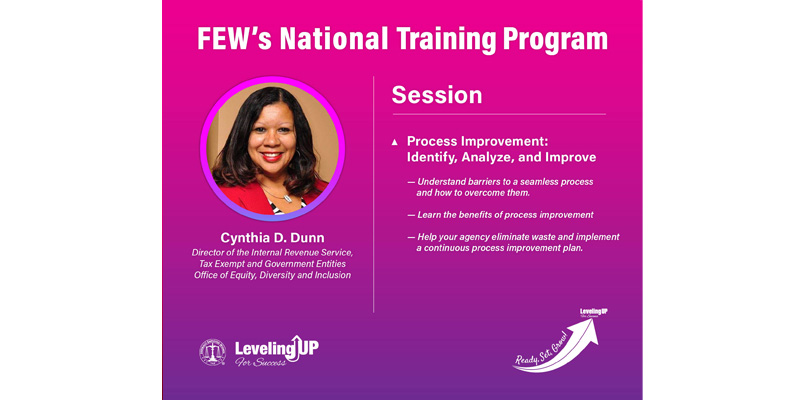Collaboration across diverse teams presents valuable opportunities to boost performance and results while strengthening your organization internally and externally. However, a recent McKinsey & Company report reveals that only 47% of organizations have the infrastructure to make transformative diversity, equality and inclusion (DEI) a reality, despite 70% expressing a desire to do so.
Lauren Golubski, vice president for diversity at Federally Employed Women (FEW) and DEI advocate, shares strategies and benefits of building diverse teams in the Federal government.
Advantages of Cultivating Diverse Teams
When thinking about diverse teams, it’s critical to begin by defining diversity and understanding what it means. Diversity is the practice or quality of including or involving people from various social and ethnic backgrounds, as well as different genders, orientations and more.
Building diverse teams in the Federal government, and any workforce for that matter, brings various experiences, backgrounds and perspectives to the table. This leads to improved problem-solving, innovation, enhanced performance and many other benefits for an agency.
Findings from a study by the Public Administration Review, a premier journal in the field of public administration research and theory, support this principle:
- When employees work together longer, higher levels of gender diversity increase performance, the study says.
- Racial diversity significantly improves agency performance and encourages teamwork and cooperation among employees.
- Higher levels of age diversity in an agency that emphasizes a results-oriented culture may increase organizational performance, reducing competition and conflicts among employees.
Approaches to Leveraging Diverse Teams
There are many ways to leverage the power of diverse teams in the Federal government to:
- Foster an inclusive environment.
- Emphasize teamwork and collaboration.
- Encourage open communication.
- Promote diversity, while recruiting and retaining through diverse hiring practices.
Yet, in order to truly accomplish this, teams must:
- Understand how to implement inclusive practices.
- Create a safe and inclusive space for all team members.
- Provide opportunities for respectful and professional discussions about challenges, differing opinions and innovative ideas.
Moreover, several systems and processes demonstrate a safe and inclusive workplace for leveraging the power of diverse teams comprising:
- Creating a safe environment that promotes trust.
- Valuing open communication.
- Connecting work with your organization’s mission.
- Building self-esteem and confidence.
- Respecting diverse cultures and customs.
- Challenging beliefs and assumptions.
Julie Battilana, a professor of organizational behavior and social innovation at the Harvard Business School and the Harvard Kennedy School, provides structures and frameworks for achieving a more balanced workplace in Power for All. She co-wrote the book with Tiziana Casciaro, a professor of organizational behavior at the Rotman School of Management at the University of Toronto.
One such framework is a power map that helps identify individuals with influence and the reasons behind their influence. She emphasizes that leadership is fundamentally determined by understanding what people value and identifying who controls access to these valued resources.
To create a more equitable and inclusive workplace, it’s essential to understand where power resides and be willing to shift power dynamics, as necessary. This will enable your organization to become more inclusive internally and within society.
An image from a Harvard Business School Online article about shifting the power balance in business illustrates the framework discussed in Battilana’s book.

Image credit: Havard Business School Online
Lastly, it’s essential to highlight and expect that all employees make mistakes, and that human behavior is truly at the core of the problem. Nonetheless, after a problem has occurred, systems and strategies, along with an opportunity for learning and growing as an organization, should be in place while eliminating exclusive and toxic work environments.
The article, Leaders as Design Architects, highlights these five basic steps for supporting good decision behavior:
- Understand the systematic errors that can occur in decision-making.
- Determine whether behavioral issues are at the heart of poor decisions.
- Pinpoint the specific underlying causes.
- Redesign the decision-making context to mitigate the negative impacts of biases and inadequate motivation.
- Rigorously test the solution.
Leaders are human, and challenges and mistakes are inevitable. How leaders respond to these situations is crucial for propelling an organization forward. Ultimately, learning from experiences and continuously improving as an organization is critical.
A Wider Range of Perspectives Leads to Better Decision-Making
Companies with above-average diversity of management teams reported innovation revenue 19 percentage points higher than companies with below-average leadership diversity. This study also shows similar practices of laying the proper foundation to support DEI efforts.
A fascinating Boston Consulting Group study (BCG)suggests that “increasing the diversity of leadership teams leads to more and better innovation and improved financial performance.”
In this case study, the factors include:
- Participative leadership: Managers value employee contributions.
- Strategic priority: Top management and the CEO visibly support diversity.
- Frequent communication: Teams have free and open discussions.
- Openness to new ideas: Employees can share their perspectives without fear of retribution.
- Fair employment practices: People in equal roles receive equal pay, and the company has strong anti-discrimination policies.
While the BCG study focuses on private sectors in six different countries, it recognizes the benefits the government sector receives when considering a more comprehensive range of perspectives, which leads to better decision-making and a more innovative government.
To fully leverage the benefits of diversity, it’s crucial to establish supportive systems and structures that promote inclusivity. This may involve implementing training programs or encouraging collaboration among teams. It’s imperative to create systems that facilitate continuous learning, personal growth, self-reflection and improvement in team dynamics. By doing so, your agency can harness all team members’ unique strengths and perspectives.
More is needed to acknowledge the presence of diversity within an organization. A profound commitment to diversity and its implementation is necessary to drive meaningful progress for current and future employees. This commitment will help your organization get closer to establishing an equitable, inclusive, welcoming and safe workplace for all individuals.
DEI Resources and Programs
FEW, a private, non-profit organization founded in 1968, is committed to providing all equal access to membership, programs, activities and opportunities, regardless of sexual orientation or gender identity.
Through its Diversity Program, FEW develops strategies to identify and eliminate barriers and increase diversity by examining the demographics of the workforce according to age, race, sex, ethnic background, religious affiliation, disability, sexual orientation, grade level and occupation within the Federal government.
FEW also seeks to expand diversity beyond the categories protected by law and regulation, including socioeconomic status, communication and thinking styles, family composition, and much more.
FEW offers in-person diversity training annually at its National Training Program (NTP), via webinars to members and non-members, and at all Regional Training Programs. Don’t miss this year’s NTP, scheduled for August 4 – 8, 2024, at the Hilton Chicago in Chicago, Illinois.
Get in touch to learn more. We’d love to hear from you.






